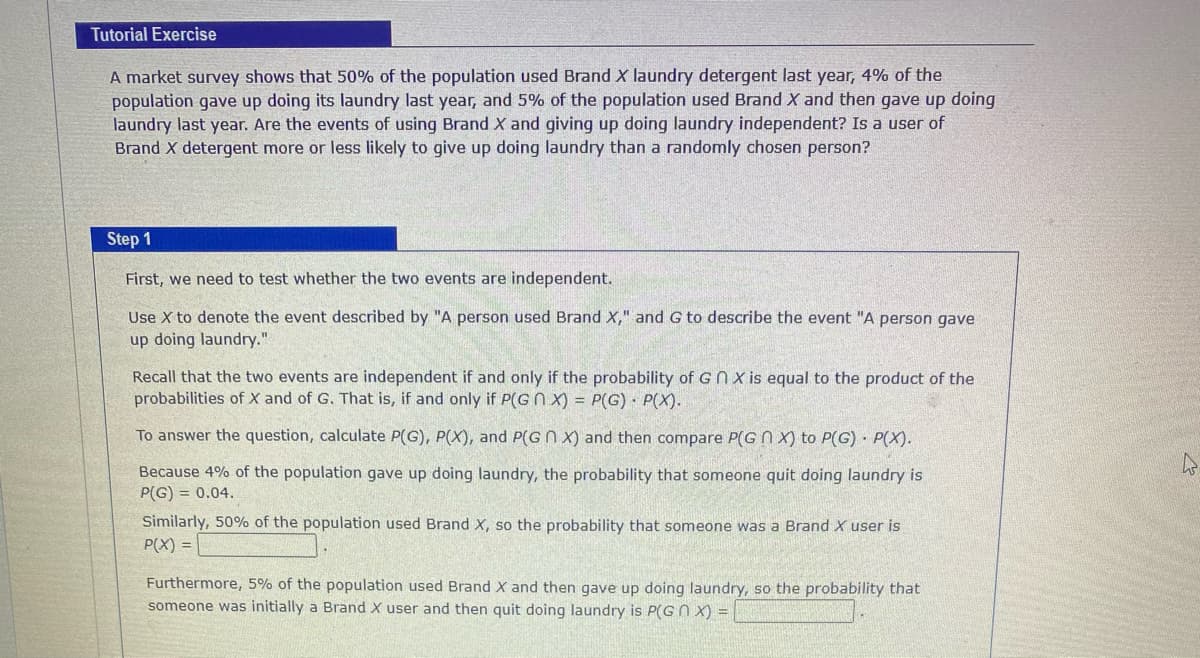Tutorial Exercise A market survey shows that 50% of the population used Brand X laundry detergent last year, 4% of the population gave up doing its laundry last year, and 5% of the population used Brand X and then gave up doing laundry last year. Are the events of using Brand X and giving up doing laundry independent? Is a user of Brand X detergent more or less likely to give up doing laundry than a randomly chosen person? Step 1 First, we need to test whether the two events are independent. Use X to denote the event described by "A person used Brand X," and G to describe the event "A person gave up doing laundry." Recall that the two events are independent if and only if the probability of G n X is equal to the product of the probabilities of X and of G. That is, if and only if P(G N X) = P(G) P(X). To answer the question, calculate P(G), P(X), and P(G N X) and then compare P(G N X) to P(G) · P(X). Because 4% of the population gave up doing laundry, the probability that someone quit doing laundry is P(G) = 0.04. Similarly, 50% of the population used Brand X, so the probability that someone was a Brand X user is P(X) = Furthermore, 5% of the population used Brand X and then gave up doing laundry, so the probability that someone was initially a Brand X user and then quit doing laundry is P(G N X) =
Tutorial Exercise A market survey shows that 50% of the population used Brand X laundry detergent last year, 4% of the population gave up doing its laundry last year, and 5% of the population used Brand X and then gave up doing laundry last year. Are the events of using Brand X and giving up doing laundry independent? Is a user of Brand X detergent more or less likely to give up doing laundry than a randomly chosen person? Step 1 First, we need to test whether the two events are independent. Use X to denote the event described by "A person used Brand X," and G to describe the event "A person gave up doing laundry." Recall that the two events are independent if and only if the probability of G n X is equal to the product of the probabilities of X and of G. That is, if and only if P(G N X) = P(G) P(X). To answer the question, calculate P(G), P(X), and P(G N X) and then compare P(G N X) to P(G) · P(X). Because 4% of the population gave up doing laundry, the probability that someone quit doing laundry is P(G) = 0.04. Similarly, 50% of the population used Brand X, so the probability that someone was a Brand X user is P(X) = Furthermore, 5% of the population used Brand X and then gave up doing laundry, so the probability that someone was initially a Brand X user and then quit doing laundry is P(G N X) =
Holt Mcdougal Larson Pre-algebra: Student Edition 2012
1st Edition
ISBN:9780547587776
Author:HOLT MCDOUGAL
Publisher:HOLT MCDOUGAL
Chapter11: Data Analysis And Probability
Section11.8: Probabilities Of Disjoint And Overlapping Events
Problem 2C
Related questions
Question

Transcribed Image Text:Tutorial Exercise
A market survey shows that 50% of the population used Brand X laundry detergent last year, 4% of the
population gave up doing its laundry last year, and 5% of the population used Brand X and then gave up doing
laundry last year. Are the events of using Brand X and giving up doing laundry independent? Is a user of
Brand X detergent more or less likely to give up doing laundry than a randomly chosen person?
Step 1
First, we need to test whether the two events are independent.
Use X to denote the event described by "A person used Brand X," and G to describe the event "A person gave
up doing laundry."
Recall that the two events are independent if and only if the probability of G n X is equal to the product of the
probabilities of X and of G. That is, if and only if P(G N X) = P(G) P(X).
To answer the question, calculate P(G), P(X), and P(G N X) and then compare P(G N X) to P(G) · P(X).
Because 4% of the population gave up doing laundry, the probability that someone quit doing laundry is
P(G) = 0.04.
Similarly, 50% of the population used Brand X, so the probability that someone was a Brand X user is
P(X) =
Furthermore, 5% of the population used Brand X and then gave up doing laundry, so the probability that
someone was initially a Brand X user and then quit doing laundry is P(Gn X) =
Expert Solution
This question has been solved!
Explore an expertly crafted, step-by-step solution for a thorough understanding of key concepts.
This is a popular solution!
Trending now
This is a popular solution!
Step by step
Solved in 2 steps

Knowledge Booster
Learn more about
Need a deep-dive on the concept behind this application? Look no further. Learn more about this topic, probability and related others by exploring similar questions and additional content below.Recommended textbooks for you

Holt Mcdougal Larson Pre-algebra: Student Edition…
Algebra
ISBN:
9780547587776
Author:
HOLT MCDOUGAL
Publisher:
HOLT MCDOUGAL

College Algebra (MindTap Course List)
Algebra
ISBN:
9781305652231
Author:
R. David Gustafson, Jeff Hughes
Publisher:
Cengage Learning

Holt Mcdougal Larson Pre-algebra: Student Edition…
Algebra
ISBN:
9780547587776
Author:
HOLT MCDOUGAL
Publisher:
HOLT MCDOUGAL

College Algebra (MindTap Course List)
Algebra
ISBN:
9781305652231
Author:
R. David Gustafson, Jeff Hughes
Publisher:
Cengage Learning